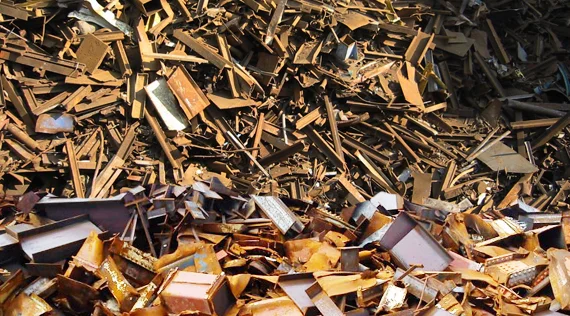
SEATTLE (Waste Advantage): The sustained high value of recycled commodities has spurred mixed waste material recovery facilities (MRFs) to install the latest technologies to recover valuable ferrous and nonferrous metals.
Choosing between mechanical or manual sorting techniques is the primary decision to be made in the design and operation of a mixed waste material recovery facility. More traditional MRFs rely heavily on manual sorting, a practice that is both expensive and inefficient when handling large volumes of material.
Despite the trade-offs between labor and capital costs, most analyses show that automated processing is far more economical than manual sorting in the long term. Furthermore, automating the sorting process also reduces health and safety risks associated with workers physically handling materials.
The tremendous advantages gained from decreased personnel hazards and increased production efficiency have led many MRFs to employ a total metal recovery system to sort and recover metals. MRF operators are now using innovative solutions to facilitate separation of valuable metals from the mixed waste stream. Considering the current surge in the price of metals, the pursuit of maximizing metal recovery has become a higher priority than ever for most operations.
The product development teams at leading manufacturers have been a driving force in the development and ongoing improvements of many recycling technologies geared toward maximizing metal recovery. This state-of-the-art equipment is significantly boosting profits for MRFs around the country. Equipment breakthroughs now enable maximum recovery—in a smaller footprint—while providing the utmost efficiency and safety.
Technology Turns into Payback
By using the most up-to-date magnetic separation equipment, single stream MRFs are recovering nearly 98 percent of the metals passing through their facilities while greatly reducing their overall landfill costs. Technological advancements applied to separation equipment allow recyclers to recover valuable ferrous and nonferrous metals less than 1-inch (2.54 cm) in size from the material stream. These results lead not only to a reduction in the amount of waste slated for the landfill, but also enable reclamation of thousands of pounds of sellable metal each day.
Manufacturers are working closely with MRF systems providers (OEMs) when recommending metal separation equipment. Technicians consider expected capacities, material composition ratios, material size, and other variables that factor into proper equipment selection. Depending on the application, suspended magnets, drum magnets, and magnetic pulleys are used to recover ferrous metals. Eddy current separators (ECS) are used to recover aluminum cans (UBCs) and other nonferrous metals.
Separation Equipment Works in Tandem for Total Recovery
A typical MRF operation uses a drum feeder to feed material into the system, followed by a series of disc screeners to separate newspaper, cardboard, and other papers from three-dimensional objects. The separation continues with a suspended self-cleaning magnet recovering ferrous material, like tin-plated steel cans. The magnet is suspended either cross-belt (perpendicular to the product flow) or inline (parallel) above the product flow.
Self-cleaning magnet systems typically feature a rubber conveyor belt, bearings, rugged channel frame, adjustable take-ups, and shaft-mounted reducer with V-belt coupling to an enclosed fan-cooled (TEFC) motor. Heavy-duty magnetic drum separators are also a popular choice for high volume ferrous recovery. These ultra-strong magnetic drums feature a heavy-duty manganese shell that is driven around a fixed magnetic element. Ferrous metals are drawn out of the waste stream by the powerful magnetic element and held against the revolving shell. The ferrous metal is released when it reaches a discharge point beyond the magnetic field.
Permanent deep field magnetic drums can be found in many MRF operations. Certain models contain rare earth permanent magnets to project a deep magnetic field capable of recovering ferrous from distances of up to 16 inches. The drum shell that contacts the ferrous material, made up of 3/8″ thick manganese steel, is abrasion resistant to extend service life.
Smaller-sized metal can be recovered downstream with a magnetic pulley, sometimes called a permanent magnet axial interpole pulley (AIP). These pulleys transform a belt conveyor into a powerful self-cleaning magnetic separator.
Ferrous material traveling down the belt conveyor enters the pulley’s magnetic field as it reaches the end of the conveyor. The tramp iron is attracted and held to the belt until it reaches the underside, passes out of the magnetic field, and separately discharged. Non-magnetic material is discharged over the pulley at its normal trajectory.
Multiple combinations of pulley diameters from 8 to 36 inches and widths from 8 to 60 inches are available. MRFs typically use these magnetic pulleys as a secondary ferrous recovery tool when smaller, hard-to-separate ferrous materials are present.
Courtesy: www.wasteadvantage.com
| Copper Scrap View All | |
| Alternator | 0.31 (0) |
| #1 Copper Bare Bright | 3.65 (0.02) |
| Aluminum Scrap View All | |
| 356 Aluminum Wheels (Clean) | 0.71 (-0.01) |
| 6061 Extrusions | 0.62 (-0.01) |
| Steel Scrap View All | |
| #1 Bundle | 475.00 (0) |
| #1 Busheling | 495.00 (0) |
| Electronics Scrap View All | |